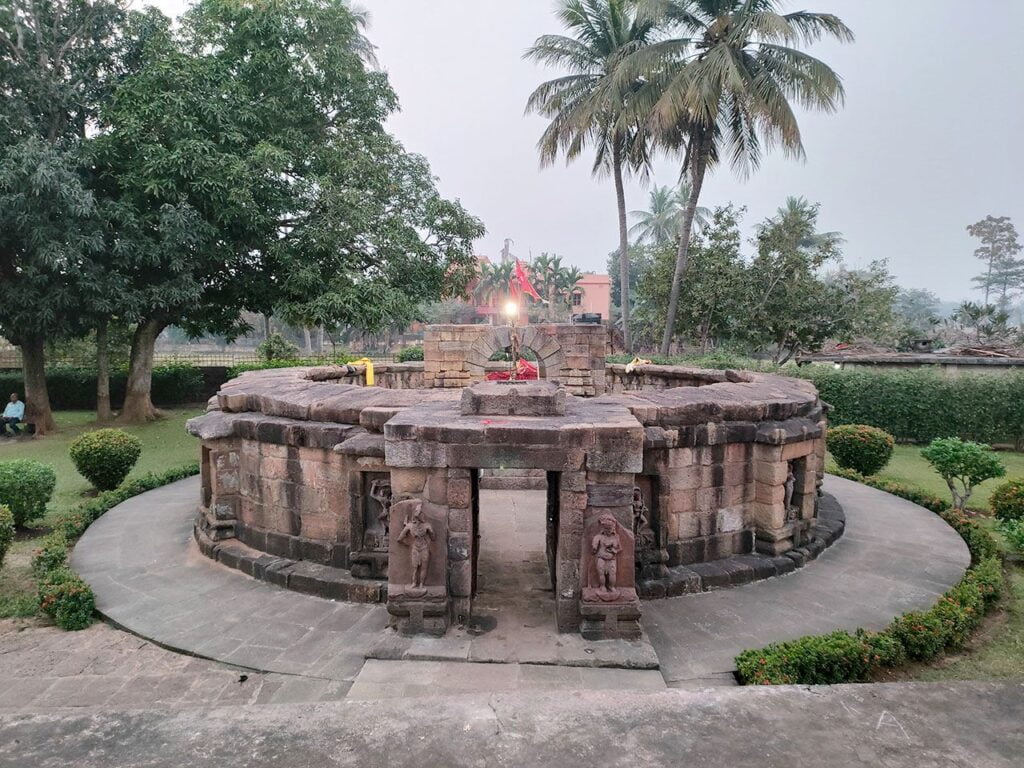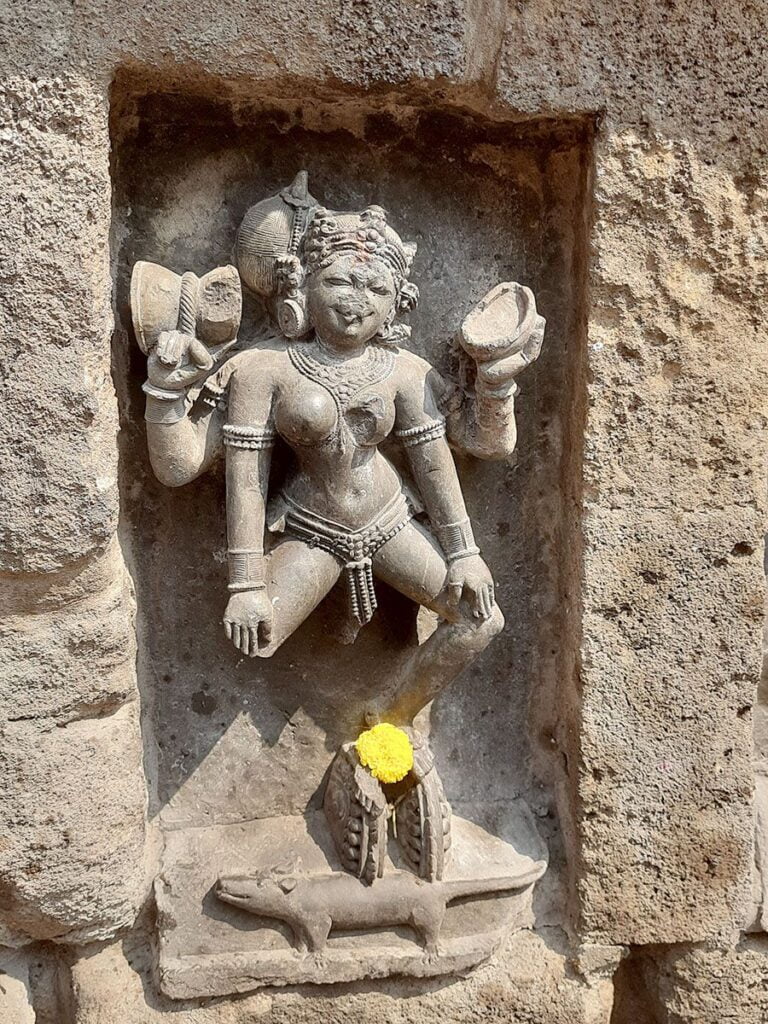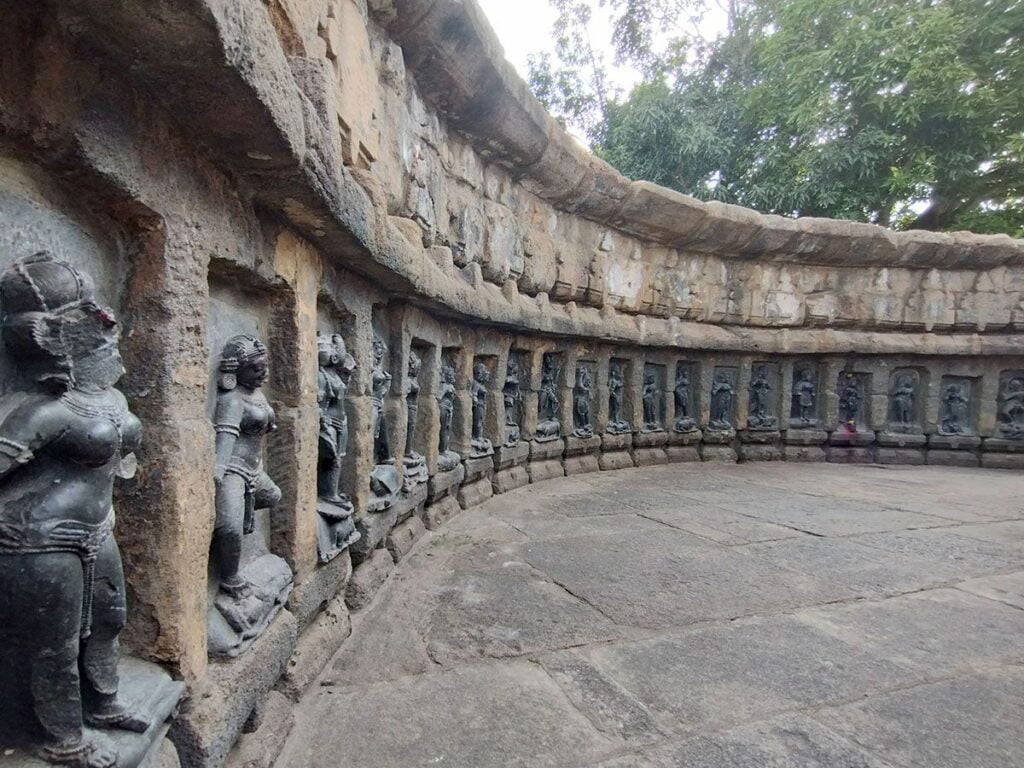64 Chausath Yogini Temple Hirapur Odisha
The Chausath Yogini Temple of Hirapur is a Hindu temple dedicated to the worship of the yoginis, auspicious goddess-like figures. It is located in the village of Hirapur, about 20 kilometers from the capital city of Bhubaneswar in the Indian state of Odisha.

Contents
- 1 History of Chausath Yogini Temple Hirapur:
- 2 Legend of Chausath Yogini Temple Hirapur:
- 3 Myths of Chausath Yogini Temple Hirapur:
- 4 Significance of Chausath Yogini Temple Hirapur:
- 5 Architecture of Chausath Yogini Temple Hirapur:
- 6 Chausath Yogini Temple Timing and Rituals:
- 7 Places to visit near Chausath Yogini Temple Hirapur:
- 8 FAQ:
- 8.0.1 What is the Chausath Yogini Temple?
- 8.0.2 When was the Chausath Yogini Temple built?
- 8.0.3 What is the architecture of the Chausath Yogini Temple?
- 8.0.4 What are the statues of the Chausath Yogini Temple?
- 8.0.5 What is the significance of the Chausath Yogini Temple?
- 8.0.6 How can I visit the Chausath Yogini Temple?
- 9 How to reach Chausath Yogini Temple Hirapur:
- 10 Google Maps:
History of Chausath Yogini Temple Hirapur:
The temple is believed to have been built by Queen Hiradevi of the Bramha dynasty during the 9th century. The legend behind the temple, according to local priests, is that the Goddess Durga took the form of 64 demi-goddesses to defeat a demon. After the fight the 64 goddesses, equated with yoginis, asked Durga to commemorate them in the form of a temple structure.
The temple is a small and circular structure, only 25 feet in diameter. It is hypaethral, meaning that it is open to the sky. The inside of the circular wall has niches, each housing the statue of a Goddess. 56 of the 64 idols, made of black stone, survive. They surround the main image at the centre of the temple, the Goddess Kali, who stands on a human head, representing the triumph of the heart over the mind. Some historians believe that an idol of Maha Bhairava was worshipped in the Chandi Mandapa.
The temple is a UNESCO World Heritage Site. It is one of the few surviving Chausath Yogini temples in India. The temple is a significant example of Hindu architecture and religious symbolism.
Read More>> Sri Puri Jagannath Temple: The Lord of the Universe

Legend of Chausath Yogini Temple Hirapur:
One prominent legend revolves around the temple’s origins. It speaks of King Yayati, cursed with old age by his father, seeking refuge in this very spot. Here, he encountered the 64 Yoginis, who blessed him with youthful vigor. In gratitude, the king built the temple to honor their mystical powers.
Another legend links the temple to the powerful tantric practitioner Matsyendranath. He is said to have performed tantric rituals within the temple’s confines, harnessing the energy of the 64 Yoginis to achieve spiritual ascension.
The 64 Yoginis themselves are a source of endless fascination. Each idol, carved from black stone, embodies a unique aspect of the divine feminine. They are depicted in various postures, holding different symbols, representing diverse powers and energies. Some legends associate them with the 64 arts and sciences, while others see them as protectors of the eight cardinal directions.
But the most intriguing legend perhaps concerns the 65th Yogini. It is said that a celestial maiden, captivated by the temple’s mystical aura, descended from the heavens and wished to join the 64 Yoginis. However, the existing goddesses refused to accept her, fearing an imbalance in their cosmic dance. The celestial maiden, heartbroken, turned to stone, forever frozen in a silent plea at the temple’s entrance.
These are just a few of the many legends that swirl around the Chausath Yogini Temple. Whether true or not, they speak to the temple’s enduring power to capture our imagination and transport us to a realm of mystery and wonder. So, if you ever find yourself in Odisha, make sure to visit this enigmatic temple and let its legends weave their magic on you.
Read More>> Biraja Temple Shakti Peeth Jaipur

Myths of Chausath Yogini Temple Hirapur:
1. The 64 Yoginis and Goddess Durga: The temple houses 64 intricately carved stone figures representing yoginis, mystical female practitioners of tantric arts. According to the most popular myth, these yoginis emerged from the form of Goddess Durga when she battled a powerful demon. After securing victory, Durga granted their wish to be worshipped in the form of a temple. Each yogini embodies a specific aspect of the divine feminine, showcasing a range of emotions and postures.
2. Queen Hiradevi and the Tantric Connection: Another legend attributes the temple’s construction to Queen Hiradevi of the Bhauma dynasty in the 9th century. It is said that the Queen was a tantric practitioner herself and sought the blessings of the yoginis for prosperity and protection. This myth explains the intricate tantric symbolism incorporated into the temple’s design.
3. Magical Powers and Spiritual Elevation: The Chausath Yogini Temple is believed to possess potent spiritual energy. Devotees come here seeking blessings for various aspects of life, including health, wealth, knowledge, and enlightenment. Some myths claim that performing specific rituals within the temple’s intricate mandala-like layout can unlock magical powers and grant wishes.
4. The Curse of Kalapahad: A darker myth speaks of Kalapahad, a 16th-century Muslim general notorious for destroying Hindu temples. It is said that he attacked the Chausath Yogini Temple, damaging several yogini statues. According to the legend, this act brought upon him terrible misfortune, leading to his eventual downfall.
5. The 64 Arts and the Cosmic Wheel: Beyond these specific stories, the number 64 holds deep significance in Hinduism. It represents the 64 Kalas (arts) associated with Goddess Saraswati, the embodiment of knowledge and creativity. The circular arrangement of the yogini figures is also likened to the cosmic wheel of Samsara, symbolizing the cycle of birth, death, and rebirth.
Read More>> Grishneshwar Temple: Wealth and Pleasure at Shiva’s Feet

Significance of Chausath Yogini Temple Hirapur:
1. Historical Significance:
- Ancient Origin: Believed to be built in the 9th century by Queen Hiradevi of the Bhauma-Kara dynasty, the temple stands as a testament to Odisha’s rich history and architectural prowess.
- Architectural Style: The hypaethral (open-air) layout with 64 niches for yogini sculptures represents a unique architectural style not commonly found elsewhere in India.
2. Spiritual Significance:
- Yogini Worship: Dedicated to the 64 yoginis, fierce aspects of the Hindu goddess Durga, the temple served as a center for tantric practices and spiritual rituals associated with them.
- Shakta Tradition: The temple aligns with the Shakta tradition of Hinduism, which focuses on the worship of the divine feminine energy.
3. Cultural Significance:
- Symbolic Representation: The 64 yoginis are believed to represent 64 different arts, sciences, and crafts, highlighting the temple’s connection to various aspects of human knowledge and cultural pursuits.
- Artistic Prowess: The intricate carvings and sculptures on the temple walls showcase the artistic skills of ancient Odia artisans.
4. Archaeological Importance:
- UNESCO World Heritage Site: The temple is part of the tentative list of UNESCO World Heritage Sites under the cultural category, recognizing its outstanding universal value.
- Preserved Legacy: The Archaeological Survey of India maintains the temple complex, ensuring its ongoing preservation for future generations.
Read More>> Shakti Peethas: The Power of Shakti

Architecture of Chausath Yogini Temple Hirapur:
Unique Circular Design:
Standing apart from the traditional Kalinga style of temple architecture, the Chausath Yogini Temple boasts a distinct circular open-air structure. This small yet captivating shrine, measuring only 25 feet in diameter and 8 feet in height, sits gracefully on the banks of the Bhargavi River.
Entrance and Pathway:
A narrow and low-lying entrance, suitable for only one person at a time, marks the entry point. As you bend your head to enter, two intricately carved doorkeepers, Jai and Vijay, welcome you. The narrow pathway leading to the main sanctum features sculptures of Kaal and Vikaal, further adding to the temple’s mystique.
Circular Sanctum and 60 Niches:
The heart of the temple lies in the circular sanctum, open to the sky. The inner wall of this sanctum is adorned with 60 niches, each one originally meant to house a statue of a Yogini, representing different aspects of the Goddess Durga. While 56 of these black granite idols have survived the passage of time, the remaining four niches stand empty.
Central Image and Symbolism:
At the center of the sanctum stands the powerful image of Goddess Kali, symbolizing the triumph of the heart over the mind. She stands atop a human head, a stark reminder of the impermanence of earthly attachments. Historians believe that an idol of Maha Bhairava, the consort of Kali, was once worshipped in the temple’s Chandi Mandapa.
Mandala Influence:
The temple layout hints at the influence of mandala principles. Concentric circles are formed with the Shiva lingam in the inner sanctum surrounded by four Yoginis and four Bhairavas. The overall plan resembles a yoni-pedestal for a Shiva lingam, adding to the temple’s spiritual significance.
Yogini Depictions:
The surviving Yogini statues are captivating in their simplicity and grace. Standing tall in various postures, each Yogini is depicted with her unique animal vehicle (vahana). Though unclothed, they are adorned with bejeweled girdles, intricate jewelry, and flowing skirts that add a touch of elegance to their forms.
Read More>> Shri Mahalaxmi Bhairabi Griba | Shri Shail Shakti Peeth

Chausath Yogini Temple Timing and Rituals:
Timings:
- The temple is open to visitors from 6 AM to 7 PM daily.
- There is no entry fee.
Rituals:
- The primary ritual at the temple involves the worship of the Bhumandala, or the five elements of nature – earth, water, fire, air, and ether. This reflects the tantric emphasis on connecting with the natural world.
- Offerings of flowers, fruits, and incense are made to the 64 Yogini shrines, each representing a different aspect of the divine feminine.
- Devotees can also perform pujas, or special prayers, seeking blessings for various aspects of life.
Places to visit near Chausath Yogini Temple Hirapur:
- Bhubaneswar: The capital city of Odisha, Bhubaneswar, is known for its rich cultural and historical heritage. You can explore various temples like Lingaraja Temple, Mukteswar Temple, and Rajarani Temple. The city also has museums, parks, and vibrant markets.
- Konark Sun Temple: A UNESCO World Heritage Site, the Konark Sun Temple is around 65 kilometers from Hirapur. It is an architectural marvel and is famous for its intricate carvings depicting various aspects of life.
- Puri: Located about 80 kilometers from Hirapur, Puri is known for the Jagannath Temple and the famous Puri Beach. The town has a spiritual and cultural ambiance and is an important pilgrimage site for Hindus.
- Dhauli Giri: Situated about 30 kilometers from Hirapur, Dhauli Giri is known for the Shanti Stupa (Peace Pagoda) and rock edicts of Ashoka. It holds historical significance as the site of the Kalinga War.
- Udayagiri and Khandagiri Caves: Located in Bhubaneswar, these caves are ancient rock-cut caves that date back to the 2nd century BCE. They offer a glimpse into Jain and Buddhist art and architecture.
- Nandan Kanan Zoological Park: Approximately 40 kilometers from Hirapur, this zoo is famous for its white tigers and a variety of other animals. It’s a great place for wildlife enthusiasts and families.
- Chilika Lake: About 110 kilometers from Hirapur, Chilika Lake is the largest coastal lagoon in India. It is a haven for migratory birds and offers boat rides to explore the serene surroundings.
- Khandagiri and Udayagiri Caves: Located in Bhubaneswar, these ancient caves are known for their historical and archaeological significance. They provide a fascinating insight into Jain and Buddhist culture.
FAQ:
What is the Chausath Yogini Temple?
The Chausath Yogini Temple is a Hindu temple located in Hirapur, Odisha, India. It is one of the oldest and most important Chausath Yogini temples in India. The temple is dedicated to the 64 yoginis, who are female deities in Hindu tantric tradition.
When was the Chausath Yogini Temple built?
The temple is believed to have been built in the 9th century by Queen Hiradevi of the Bhanja dynasty. However, there is no definitive evidence to support this claim.
What is the architecture of the Chausath Yogini Temple?
The temple is circular in shape and has a diameter of about 25 feet. It is made of sandstone and has no roof. The walls of the temple are decorated with sculptures of yoginis, animals, and other religious symbols.
What are the statues of the Chausath Yogini Temple?
The statues of the yoginis are made of black stone and are about 2 feet tall. Each statue is unique and represents a different aspect of the divine feminine. Some of the yoginis are shown riding animals, while others are shown holding weapons or other objects.
What is the significance of the Chausath Yogini Temple?
The Chausath Yogini Temple is a significant religious and cultural site. It is a reminder of the rich history and traditions of Hinduism. The temple is also a popular tourist destination.
How can I visit the Chausath Yogini Temple?
The Chausath Yogini Temple is located in Hirapur, which is about 18 kilometers from Bhubaneswar, the capital of Odisha. The temple is open to the public from 6am to 7pm. There is no entry fee.
How to reach Chausath Yogini Temple Hirapur:
- By Air: The nearest airport to Hirapur is the Biju Patnaik International Airport in Bhubaneswar, which is approximately 80 kilometers away. From the airport, you can hire a taxi or use other local transportation options to reach Hirapur.
- By Train: The nearest major railway station is in Bhubaneswar. From Bhubaneswar, you can take a train to Khurda Road Junction, which is around 20 kilometers from Hirapur. After reaching Khurda Road Junction, you can hire a taxi or take a bus to reach Hirapur.
- By Road:
- From Bhubaneswar: Hirapur is well-connected by road, and you can hire a taxi or take a bus from Bhubaneswar. The distance is approximately 70-80 kilometers, and the journey may take around 2-3 hours depending on the mode of transportation.
- From Khurda: If you are traveling by train and reach Khurda Road Junction, you can hire a taxi or take a bus to reach Hirapur, which is about 20 kilometers away.
- Local Transportation: Once you reach Hirapur, you may need to rely on local transportation options like auto-rickshaws or cycle rickshaws to reach the Chausath Yogini Temple specifically. The temple is a bit off the main road, and local transportation can help you navigate the narrow lanes.

One Comment